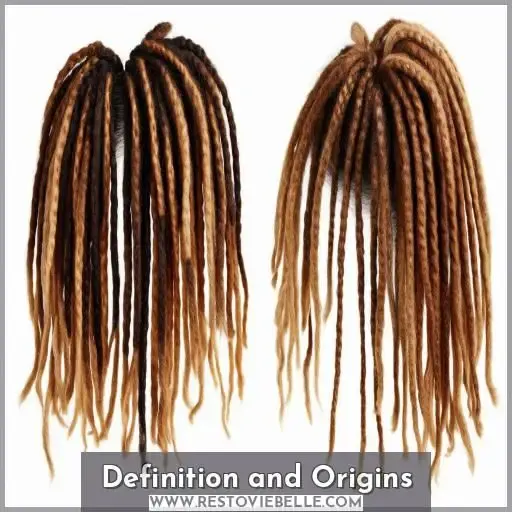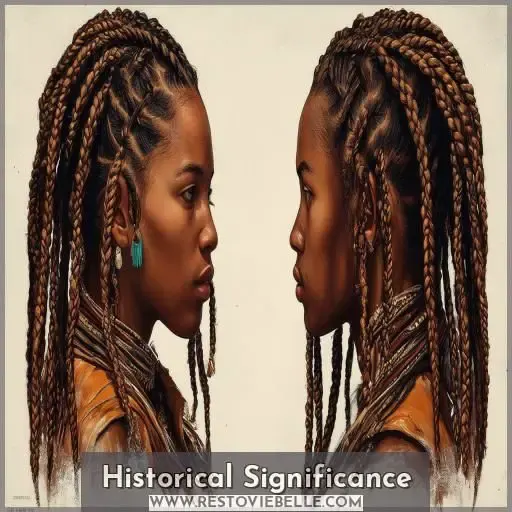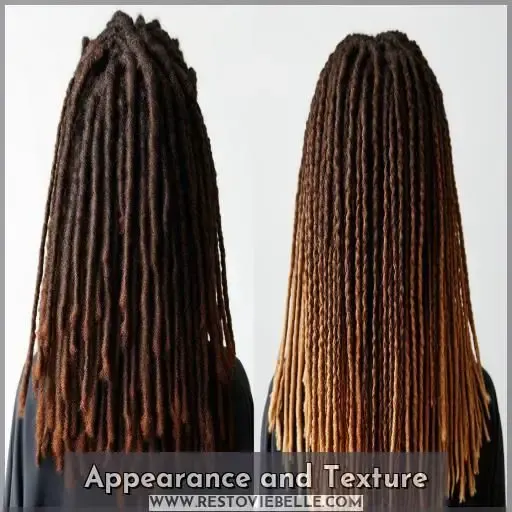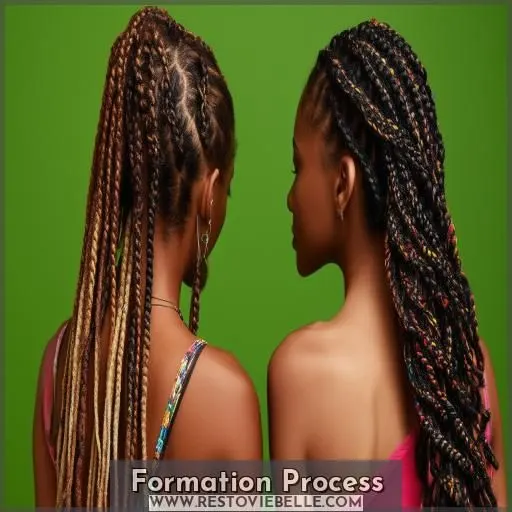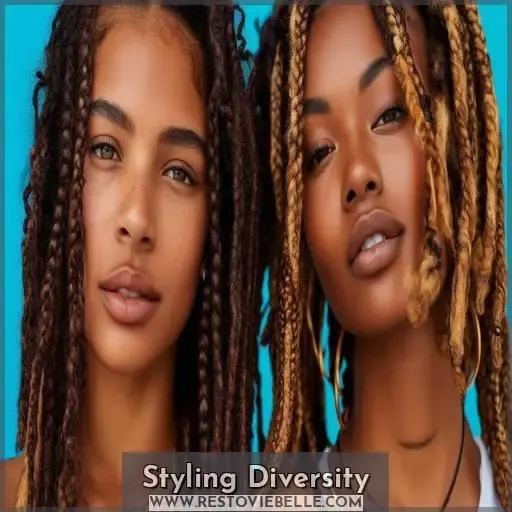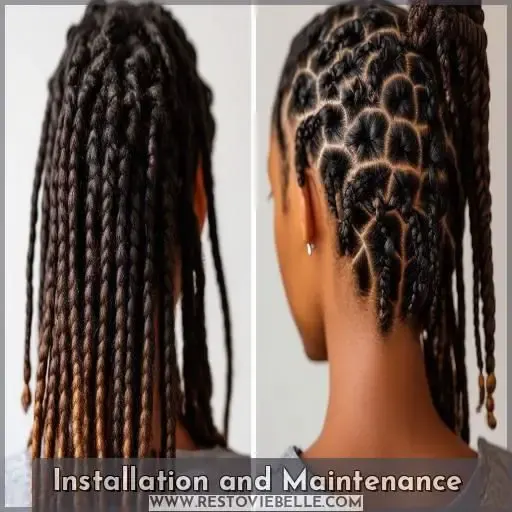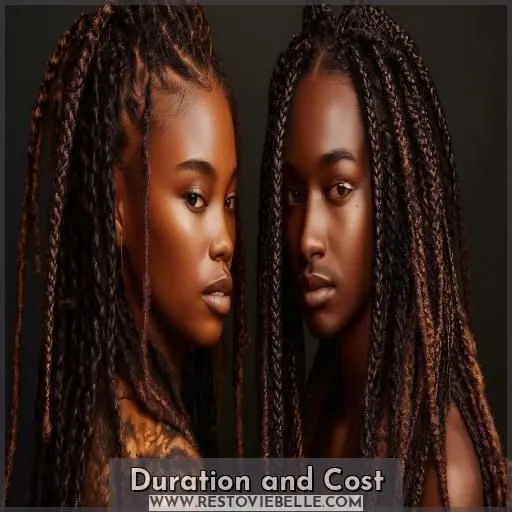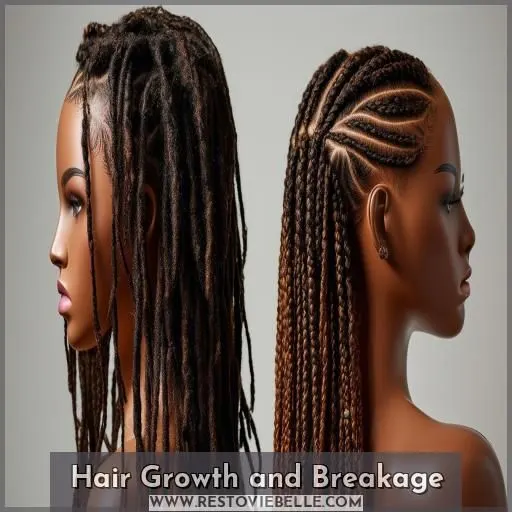This site is supported by our readers. We may earn a commission, at no cost to you, if you purchase through links.
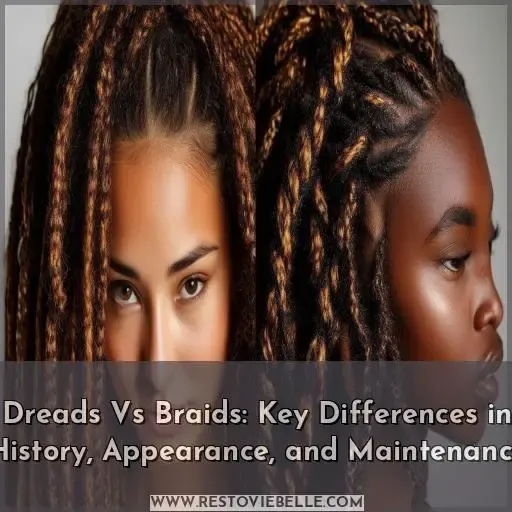 Understanding the differences between dreads and braids helps you appreciate their rich history and unique characteristics. Dreads, with their rope-like strands formed through matting, trace back to African culture and symbolize strength and rebellion.
Understanding the differences between dreads and braids helps you appreciate their rich history and unique characteristics. Dreads, with their rope-like strands formed through matting, trace back to African culture and symbolize strength and rebellion.
Braids, dating back to 3500 BC, are intricate interwoven patterns used for cultural identification in various societies. Appearance-wise, dreads are cylindrical and rugged, while braids are flatter with versatile designs.
Dreads require minimal maintenance but take time to form, whereas braids need regular care but offer quick, diverse styling options. Ready to dive deeper into their origins and upkeep? Keep on as there’s much more to explore!
Table Of Contents
- Key Takeaways
- Definition and Origins
- Historical Significance
- Appearance and Texture
- Formation Process
- Styling Diversity
- Installation and Maintenance
- Duration and Cost
- Hair Growth and Breakage
- Frequently Asked Questions (FAQs)
- What’s better, dreads or braids?
- Will my braids turn into dreads?
- What’s the difference between dreads and locs?
- Do dreadlocks count as braids?
- How often should dreads be washed?
- Can braids or dreads cause scalp infections?
- Which hairstyle is better for athletic activities?
- Are there cultural sensitivities around braids and dreads?
- What are the environmental impacts of maintaining dreads?
- Conclusion
Key Takeaways
- Dreads and braids have their own groove: Dreads, rooted in African culture, symbolize strength and rebellion, while braids, with a global presence, showcase cultural identity and diversity.
- Appearance-wise, they’re like night and day: Dreads rock a cylindrical, rugged look, while braids slay with flatter, versatile designs.
- Upkeep is a balancing act: Dreads are low-maintenance once formed, but getting there takes time. Braids need regular TLC to keep their styles fresh.
- Respect the roots: Remember, dreads and braids carry cultural significance, so always approach them with appreciation and understanding.
Definition and Origins
In understanding dreads and braids, you’ll see that dreads are formed as hair strands lock over time into rope-like structures, while braids are created by interweaving three or more hair strands. Their origins are distinct, with dreads deeply rooted in African culture, and braids appearing worldwide as early as 3500 BC.
Dreads: Rope-like Hair Strands That Lock Over Time
Dreads, also known as locs or dreadlocks, are rope-like hair strands that lock over time, deeply rooted in African culture. The formation involves allowing hair to intertwine and mat together naturally or through techniques like palm rolling. Here’s how they stand out:
- Symbolism: Often connected to hair spirituality and cultural identity.
- Variety: Dreadlock styles include natural, freeform, or curated formations.
- Accessories: Enhance with dreadlock extensions or dreadlock jewelry.
Braids: Interwoven Hair Structures Created by Combining Strands
Braids are intricate interwoven structures made by combining three or more hair strands, dating back to 3500 BC. Rich in cultural impact, they represented social status, religion, and ethnicity.
Originating in African cultures, braided hairstyles like cornrows held religious significance and societal perceptions. These grooming practices involve various techniques, and the addition of hair accessories showcases individuality and style diversity, making braids an essential part of hairstyling traditions globally.
Historical Significance
Dreads have deep roots in African culture, with historical evidence spanning centuries . Braids, dating back to around 3500 BC, appear in various cultures globally, often used for cultural identification and social significance .
Dreads: Associated With African Culture, Dating Back Centuries
Dreads, known for their cylindrical, rope-like appearance, have deep roots in African cultures, symbolizing cultural identity and spiritual significance. Historically, they’ve been associated with strength and rebellion against oppression.
The Rasta movement further popularized dreads, linking them to reggae music and Rastafarian culture. Over centuries, dreads have remained a powerful symbol of African heritage and resistance, embodying the resilience and unity of African peoples .
Braids: Originating Around 3500 BC in Diverse Cultures Worldwide
Braids, originating around 3500 BC, showcase the rich diversity and cultural significance across various global societies. Over time, braids have become a versatile and popular choice, reflecting each culture’s unique identity and style.
- Symbol of status and power
- Medium for communication, telling stories
- Protective hairstyles, preserving hair health
- Varied installation methods, reflecting regional customs
- Styles ranging from simple to intricate patterns
These elements contribute to braid versatility and enduring appeal.
Appearance and Texture
When comparing dreads and braids, you’ll notice that dreads have a cylindrical, rope-like appearance with a rough texture. In contrast, braids are flatter with distinctive patterns created by weaving multiple hair strands.
Dreads: Cylindrical, Rope-like, With a Rough Texture
Regarding dreads, their cylindrical, rope-like shape is renowned.
Dreadlocks present a rugged and dense appearance with a distinctive rough texture that exudes a natural, untamed aura.
Thickness and length can fluctuate significantly, reflecting one’s personal style and proficiency in their upkeep.
Adopt this heritage-rich hairstyle to convey a confident, bold statement with your hair’s form and texture.
There’s power in the locs.
Braids: Flatter, With Distinctive Patterns and Woven Divisions
Braids are much flatter compared to dreads and feature distinctive patterns and woven divisions, making each braid unique. They’re versatile in their design and can be a true fashion statement with numerous types like box braids and micro braids.
- Braid patterns: intricate and varied
- Braid tension: needs to be balanced for comfort
- Braid length: can vary significantly
- Braid adornments: beads, cuffs, threads
- Braid placement: customizable for different styles
Formation Process
To create dreads, you lock and matte your hair strands over time until they form rope-like structures. Braids, on the other hand, are formed by parting your hair and alternatingly weaving the strands to create intricate patterns.
Dreads: Formed Through Locking and Matting Hair Strands
Dreads form through locking and matting hair strands, embracing cultural significance and natural beauty. You allow hair to tangle and intertwine, creating solid, cylindrical ropes over time. This requires patience and minimal maintenance. Here’s a quick comparison:
| Aspect | Dreads | Braids |
|---|---|---|
| Texture | Rough and rope-like | Smooth and woven |
| Formation Time | Weeks to months | Hours |
| Maintenance | Low | Moderate |
| Tools | Crochet hooks, hands | Comb, hands |
| Cultural Ties | African, Rastafarian roots | Global, diverse |
Braids: Created by Partitioning Hair and Weaving Strands Alternately
Creating braids involves partitioning hair and weaving strands alternately, reflecting a rich tapestry of cultural significance across different cultures dating back to 3500 BC .
This protective hairstyle serves as cultural identification and offers low maintenance.
While braiding minimizes hair knots, it can lead to hair damage if not done properly.
Unlike dreads, braids allow diverse styling options with patterns distinct from matted locks .
Styling Diversity
When comparing dreads and braids, the styling diversity varies greatly. Dreads have limited styling options due to their matted texture, influenced by cultural significance and personal identity tied to reggae music culture and reggae heads. On the other hand, braids offer numerous styles and patterns, allowing you to express aesthetic preferences and social acceptance through your hair.
Consider the following styling aspects:
- Versatility: Braids allow for various styles like box braids, cornrows, and goddess braids.
- Accessories: With braids, you can easily add beads, cuffs, and colorful extensions.
- Options: Dreads can be styled into updos or ponytails but remain cylindrical and rope-like.
- Hair Care: Braids need regular conditioning and moisturizing, while dreads benefit from less frequent maintenance and the use of natural products like witch hazel .
Installation and Maintenance
After exploring the diverse styling options between dreads and braids, it’s essential to understand their installation and maintenance differences.
When installing dreads, you’ll typically use interlocking or the crochet method, which can take days, weeks, or even months to complete . This extensive process results in a very low-maintenance hairstyle, requiring occasional re-twisting based on root density and new growth . Dreads care involves regularly conditioning, moisturizing, and lubricating your hair to prevent breakage (Source).
Conversely, braids are installed much faster, taking between half an hour to 2 hours, using a simple three-strand method . Braids care also requires conditioning, moisturizing, and lubricating, but they need re-installation every 4-6 weeks to maintain their integrity and prevent breakage. This makes braids relatively low maintenance too.
Duration and Cost
When considering the time and expenses, braids last up to 8 weeks and typically cost between $75 and $450, making them a temporary yet affordable choice. Dreads, on the other hand, can last for months or even years, but their cost can range from $48 to $1,400 depending on the method and maintenance involved (Source).
Braids: Last Up to 8 Weeks, Cost $75 to $450
Braids offer a protective hairstyle with a lifespan of up to 8 weeks, costing between $75 to $450 depending on complexity and stylist expertise . Regular reinstallation every 4-6 weeks reduces breakage and maintains style integrity by addressing new growth and worn-out sections . Moisturize and condition your braids to keep them healthy and prevent dryness, ensuring they remain sleek and manageable .
Dreads: Last Months or Years, Cost $48 to $1,400
Dreadlocks have a long lifespan, lasting months or even years with proper care. The installation process can involve various techniques and is often pricey, ranging from $48 to $1,400, depending on complexity and expertise. To maintain your dreadlocks:
- Regularly wash and retwist to avoid buildup.
- Use natural oils for moisture.
- Avoid over-manipulation to prevent breakage.
- Sleep with a satin cap to prevent frizz.
Hair Growth and Breakage
When you’re considering hair growth and breakage, both dreads and braids have distinct characteristics. Dreads can grow at a rate of 2.5 to 3 inches per month and are known for their durability. However, breakage in dreads occurs through thinning, root damage, and length breakage, making maintenance critical.
For braids, expect growth rates of 1-2 inches per month. Re-installing braids every 4-6 weeks is essential to avert breakage and scalp damage. This approach guarantees healthier hair density and minimizes damage, making your style resilient and long-lasting.
Frequently Asked Questions (FAQs)
What’s better, dreads or braids?
Deciding between dreads and braids means considering your lifestyle and hair needs. Dreads offer durability and low maintenance, while braids provide styling versatility and protective benefits. Which one matches your personal style and maintenance preference?
Will my braids turn into dreads?
Yes, over time, your braids can turn into dreads if you leave them untreated, as the hair will naturally lock and mat due to the lack of maintenance and grooming .
What’s the difference between dreads and locs?
Locs and dreads are fundamentally the same, both involving locked hair. The term "locs" is preferred within the African community to avoid the negative connotations associated with "dreadlocks" .
Do dreadlocks count as braids?
No, dreadlocks aren’t considered braids. Braids are interwoven structures using three or more strands, while dreadlocks form by locking and matting hair strands, creating rope-like structures. They differ both in appearance and formation methods .
How often should dreads be washed?
Rhythm in routine, that’s your mantra. Wash your dreads every 7-10 days to keep them clean without unraveling. Use residue-free shampoo, ensuring a thorough rinse to prevent buildup and promote healthy locs .
Can braids or dreads cause scalp infections?
Yes, braids and dreads can cause scalp infections if not properly maintained. Tight braids can lead to sores and inflammation, while improper cleaning of dreads may result in infections and scalp issues .
Which hairstyle is better for athletic activities?
For athletic activities, braids outshine dreads by miles. They offer more style options, stay put during movement, and cause less discomfort. Perfect for high-energy sports quick and easy to maintain.
Are there cultural sensitivities around braids and dreads?
Yes, there are cultural sensitivities around braids and dreads often tied to cultural identification and historical significance in African societies. Misuse can be considered cultural appropriation, sparking controversy, and affecting communal bonds .
What are the environmental impacts of maintaining dreads?
Maintaining dreads impacts the environment through water usage during regular washing, potential chemical runoff from hair products, and the accumulation of non-biodegradable materials from synthetic locking aids and products used for maintenance .
Conclusion
Knowledge is power."
Knowing the rich history and distinct characteristics of dreads and braids can help you choose the best hairstyle for your needs. Both styles boast unique origins, appearances, and maintenance requirements. Dreads offer a rugged, long-lasting look, while braids provide quick, diverse styles.
With dreads, patience is key; with braids, regular upkeep is paramount. By understanding "dreads vs braids," you can confidently decide which style suits your lifestyle and preferences (Source).
